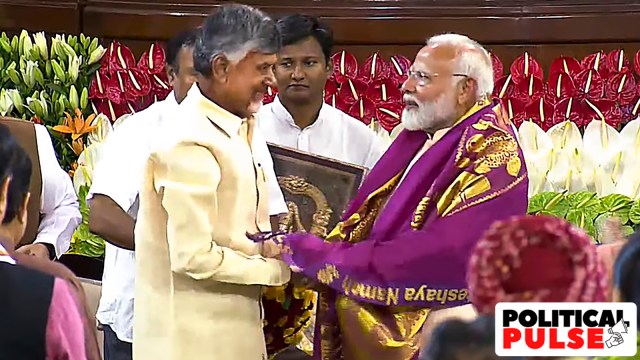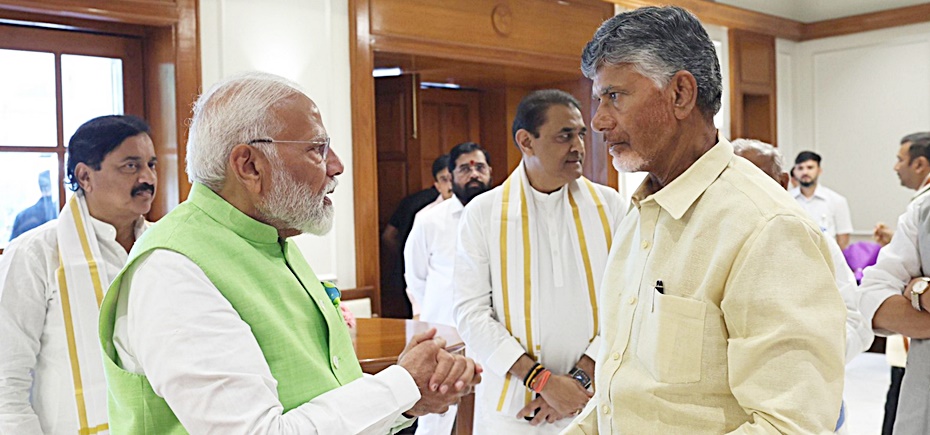2002 Gujarat riots, special status: Why most-valued partner TDP left NDA earlier
Chandrababu Naidu-led TDP had been part of the NDA first during the Vajpayee government, and had ministers in Modi’s first government
 Narendra Modi being felicitated by TDP chief N Chandrababu Naidu during the NDA parliamentary party meeting on Friday. (PTI)
Narendra Modi being felicitated by TDP chief N Chandrababu Naidu during the NDA parliamentary party meeting on Friday. (PTI)Coalition governments once used to be a mainstay of the Indian political landscape. Now, there is a return to the same after two terms of the BJP’s majority government.
In the results declared on Tuesday, the BJP was reduced to 240 seats, failing to reach the majority mark of 272. This leaves it dependent on the support of its allies, particularly Chandrababu Naidu’s Telugu Desam Party (TDP), which has 16 seats, and Nitish Kumar’s Janata Dal (United), with a strength of 12 seats.
Both the parties have put forth a list of demands, including preference for ministerial berths and the Speaker’s post.
The JD(U)’s tryst with the NDA is a well-told story, involving various exits and re-entries. However, the TDP’s too has been pretty eventful, including several threats to leave and snapping of ties:
1999-2004
The 1999 Lok Sabha elections followed the collapse of an NDA government led by Atal Bihari Vajpayee in 13 months. This government, which included the TDP and JD(U), fell after it was defeated in a vote-of-confidence by just one vote.
In the 1999 Lok Sabha elections, the BJP got 182 seats on its own. The TDP was then the second biggest party in the NDA, with 29 seats, followed closely by the JD(U) at 21. The TDP-BJP alliance also paid dividends for the BJP in Andhra, leading to seven Lok Sabha seats for the party from the state.
 Narendra Modi and Chandrababu Naidu at an NDA meeting on Wednesday. (PTI)
Narendra Modi and Chandrababu Naidu at an NDA meeting on Wednesday. (PTI)
Apart from these three, 14 other parties came together to form an NDA government, headed again by Vajpayee.
In his book Divided we Govern, Coalition Politics in India, political scientist Sanjay Ruparelia writes “that the TDP maintained a formal political neutrality vis-à-vis the BJP, in exchange for retaining dominance in Andhra Pradesh.”
However, Naidu also ensured his way on several issues.
“The BJP moderated its agenda at the behest of its newfound allies. Reportedly, the TDP warned the BJP that it would withdraw parliamentary support if the latter ‘passed any policies that harmed minorities’ or undermined the ‘secular fabric’ of the country,” writes Ruparelia.
In August 2000, Naidu accused the 11th Finance Commission of “encouraging fiscal profligacy by rewarding high population-low economic growth states like Bihar and Uttar Pradesh as well as Assam and West Bengal, while penalising the low population-high economic growth performance of Gujarat, Maharashtra, Andhra Pradesh, Karnataka and Tamil Nadu.,” writes Ruparelia.
Things came to a head, though, after the 2002 Godhra riots in Gujarat, which then had a government led by Narendra Modi.
In April 2002, Naidu demanded the resignation of Modi. This was backed by other NDA partners such as the Trinamool Congress, Lok Janshakti Party (LJP) and JD(U) – the latter two are also current partners of the NDA. All four parties boycotted a subsequent meeting called by the NDA central committee.
“The TDP issued a virtual ultimatum, demanding that ‘the BJP immediately effect a change of leadership in Gujarat’.” Unless Modi was removed, it said, “We will be guilty of eroding public confidence and failing to provide just and fair governance”.
Saying that “adherence to secularism was one of his basic conditions for support to the NDA”, the TDP said: “Any negation of this approach would be unacceptable. The recent developments in Gujarat have been a matter of grave concern and have tarnished India’s image of being a liberal, modem and secular society.”
Naidu subsequently even called for a snap election in Gujarat.
The NDA went on to pass a resolution and “categorically rejected” the idea, and said that in a federal polity, “interference in the democratic functioning of States, or Delhi determining who is or is not to be the chief minister of a particular State, will completely distort the constitutional balance of federalism”.
This resolution was incidentally even backed by strong regional forces such as the DMK, which was a part of the NDA at the time.
Naidu, however, kept up the demand. The NDA even went on to issue a resolution appealing to “valued friend” TDP not to withdraw and indicated that a snap poll in Gujarat wasn’t imminent.
The TDP replied saying it hadn’t discussed the issue of withdrawal of support. Ultimately, Naidu did not withdraw support.
Then came the 2004 Lok Sabha elections, when the BJP’s “India Shining” campaign did not take off. The BJP’s tally fell from 182 to 138, and the NDA’s count fell from 299 to 189.
The TDP also saw a drubbing in the Andhra Assembly polls, winning only 47 seats. Its tally in the Lok Sabha fell to five seats. Following the polls, the TDP left the coalition, citing the Gujarat riots.
2014
Just ahead of the first phase of polling in the 2014 Lok Sabha elections, Naidu re-joined the NDA, after some mediation by Akali Dal leader Naresh Gujaral. This was after the 2014 bifurcation of Andhra Pradesh, which had left the Congress hugely unpopular in the state.
“What is important is we have to defeat the Congress at the national level. This is a historic tie-up and I am confident the NDA will win 300 seats. I appeal to all TDP and BJP leaders not to oppose this and instead unite to win in this election’’ Naidu said.
The TDP subsequently came to power in the Andhra polls, held simultaneously with the Lok Sabha polls, with the TDP also winning 16 Lok Sabha seats, and the BJP two from the state.
But issues again cropped up, this time over the TDP government’s demand for special category status for Andhra. This was one of the provisions of the Andhra Pradesh Reorganisation Act, which led to the formation of Telangana in June 2014.
In March 2018, Naidu asked his two ministers at the Centre — P Ashok Gajapati Raju (Civil Aviation) and Y Satyanarayana Chowdary (MoS, Science and Technology and Earth Sciences) — to resign over the failure of the demand.
A week later, the party left the NDA.
On the decision, Naidu told the Andhra Pradesh Assembly: “I took the decision in the interest of the people of Andhra Pradesh and not for any selfish, personal reason. Everyone knows that for four years we tried hard and made all efforts to secure whatever was promised to the state as per the Andhra Pradesh Reorganisation Act, 2014. I went to New Delhi 29 times but there was no response. The last Budget was a big disappointment as there was no mention of our state. When the BJP’s allies are fighting for their rights in Parliament, can’t the Prime Minister give some time to address them?’’
Writing to BJP president Amit Shah, Naidu said the TDP “joined the alliance with the hope that our state will get fair treatment and with an expectation that our people will get justice. When our being in the alliance doesn’t serve that purpose, we feel that it is pointless to continue.”
Simultaneously, Thota Narasimhan, the floor leader of the TDP in the Lok Sabha, gave notice to move a no-confidence motion against the BJP-led government. This was the first no-confidence motion to have been admitted in 15 years, and got the backing of the Congress, TDP, TMC, NCP, CPI-M, AAP and RJD.
After a 12-hour debate in that year’s Monsoon Session, on July 20, the Modi government defeated the no-confidence motion in the Lok Sabha by 199 votes. While 126 members supported the motion, 325 MPs rejected it.
On the issue of Andhra, Modi in his speech attacked the Congress on how it bifurcated the state and claimed it ostensibly reaped political dividends. He compared it to the creation of Jharkhand, Chattisgarh, and Uttarakhand by the Vajpayee government, and pointed out that there were no fights in any of those cases.
Creating divisions, he said, was not new for the Congress, referring to Partition. And said that for both of these moves, the people were still paying the price.
As the no-confidence motion was moved by the TDP’s Kesineni Srinivas, he responded to Modi. But he was cut short by Speaker Sumitra Mahajan, who said he wasn’t raising any substantial points and only focusing on jibes at the PM, calling him a “drama artist” and an “actor”.
2024
While following their 2018 split, Naidu and BJP leaders kept up their attacks on each other, before the Assembly and Lok Sabha polls this time, they tied up again — after much negotiation and back and forth. This time, their alliance for Andhra included a third big partner, JanaSena Party, which also ended very well in both the Lok Sabha and Assembly polls.
The seat talks were stuck as Naidu did not want to part with more than 4-5 Lok Sabha seats for the BJP out of 25 in Andhra Pradesh. Of the 175 seats in the Assembly, he was ready to give the BJP only 15. Eventually, the TDP offered 8 Lok Sabha seats to the BJP, on the condition that it shared it with the JSP.
- 01
- 02
- 03
- 04
- 05






























